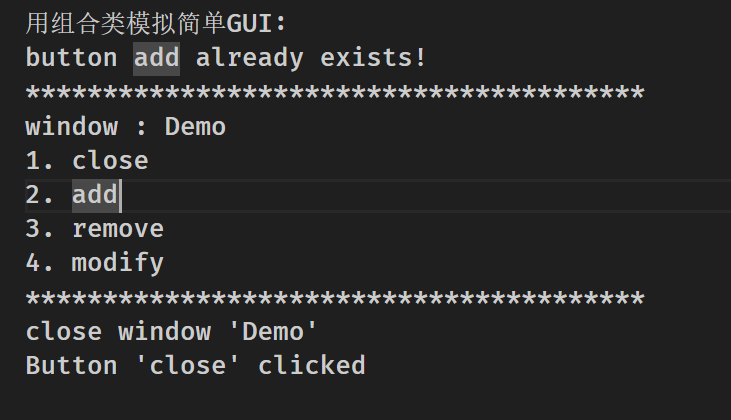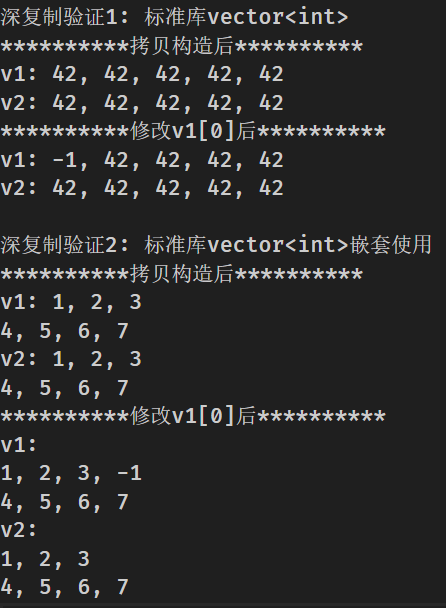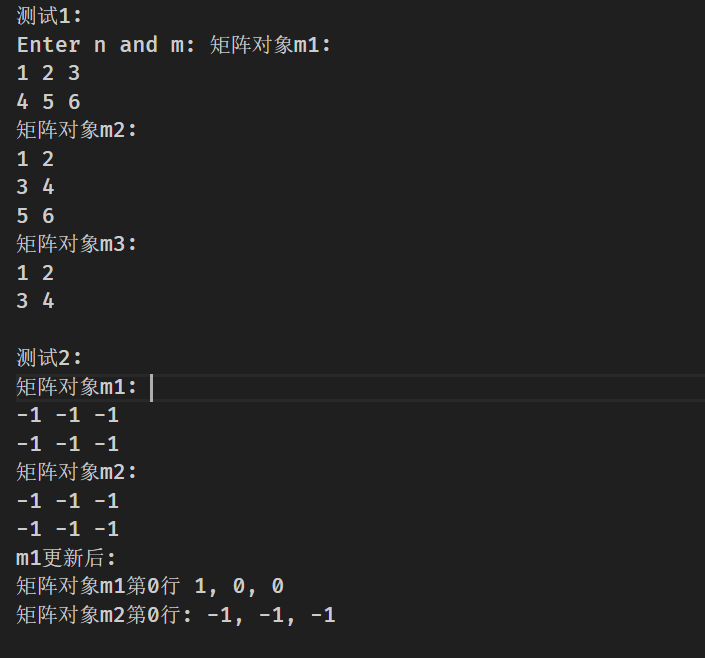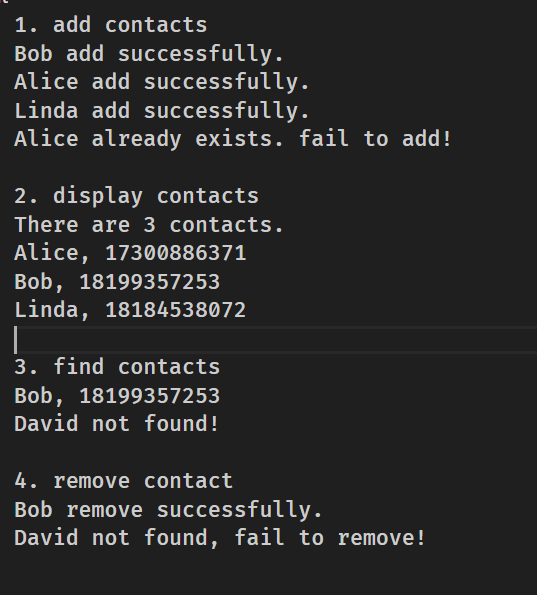实验三
实验3
实验任务一
源代码
button.hpp
#pragma once
#include <iostream>
#include <string>
class Button
{
public:
Button(const std::string &label_);
const std::string &get_label() const;
void click();
private:
std::string label;
};
Button::Button(const std::string &label_) : label{label_}
{
}
inline const std::string &Button::get_label() const
{
return label;
}
inline void Button::click()
{
std::cout << "Button '" << label << "' clicked\n";
}
window.hpp
#pragma once
#include <iostream>
#include <vector>
#include <algorithm>
#include "button.hpp"
// 窗口类
class Window
{
public:
Window(const std::string &title_);
void display() const;
void close();
void add_button(const std::string &label);
void click_button(const std::string &label);
private:
bool has_button(const std::string &label) const;
private:
std::string title;
std::vector<Button> buttons;
};
Window::Window(const std::string &title_) : title{title_}
{
buttons.push_back(Button("close"));
}
inline void Window::display() const
{
std::string s(40, '*');
std::cout << s << std::endl;
std::cout << "window : " << title << std::endl;
int cnt = 0;
for (const auto &button : buttons)
std::cout << ++cnt << ". " << button.get_label() << std::endl;
std::cout << s << std::endl;
}
inline void Window::close()
{
std::cout << "close window '" << title << "'" << std::endl;
click_button("close");
}
inline bool Window::has_button(const std::string &label) const
{
for (const auto &button : buttons)
if (button.get_label() == label)
return true;
return false;
}
inline void Window::add_button(const std::string &label)
{
if (has_button(label))
std::cout << "button " << label << " already exists!\n";
else
buttons.push_back(Button(label));
}
inline void Window::click_button(const std::string &label)
{
for (auto &button : buttons)
if (button.get_label() == label)
{
button.click();
return;
}
std::cout << "no button: " << label << std::endl;
}
task1.cpp
#include "window.hpp"
#include <iostream>
void test()
{
Window w("Demo");
w.add_button("add");
w.add_button("remove");
w.add_button("modify");
w.add_button("add");
w.display();
w.close();
}
int main()
{
std::cout << "用组合类模拟简单GUI:\n";
test();
}
运行结果截图

回答问题
问题1:这个范例中, Window 和 Button 是组合关系吗?
是组合关系。
问题2: bool has_button(const std::string &label) const; 被设计为私有。 思考并回答:
(1)若将其改为公有接口,有何优点或风险?
优点:
提供查询功能:外部代码可以检查窗口中是否存在特定按钮
增强灵活性:允许客户端代码在添加按钮前进行预检查
更好的调试支持:便于测试和验证窗口状态
风险:
暴露内部实现细节:外部代码可能过度依赖这个查询机制
增加接口复杂度:不必要的公有接口会使类的API变得臃肿
潜在的逻辑错误:外部代码可能基于查询结果做出错误假设(比如查询后按钮状态可能已改变
(2)设计类时,如何判断一个成员函数应为 public 还是 private?(可从“用户是否需要”、“是否仅为内部实现细节”、“是否易破坏对象状态”等角度分析。)
用户是否需要 - 只暴露用户真正需要的操作
内部实现细节 - 仅为内部使用的函数保持私有
最小权限原则 - 公有接口越简洁越好
状态安全性 - 避免暴露可能导致错误使用的功能
问题3: Button 的接口 const std::string& get_label() const; 返回 const std::string& 。对比以下两种接口设计在性能和安全性方面的差异并精炼陈述。
接口1: const std::string& get_label() const;
接口2: const std::string get_label() const;
接口2更安全但性能略低;接口1更高效但需谨慎使用。对于简单字符串,推荐接口2,性能损失可忽略但安全性更高。
问题4:把代码中所有 xx.push_back(Button(xxx)) 改成 xx.emplace_back(xxx) ,观察程序是否正常运行;查阅资料,回答两种写法的差别。
可以正常运行,在C++中,push_back和emplace_back都是STL容器(如vector)中用于在容器末尾添加元素的成员函数。它们的主要区别在于它们添加元素的方式和性能。
push_back 函数会创建一个新元素,然后将其拷贝或移动到容器中。如果传递给push_back的是一个临时对象(右值),它会调用移动构造函数;如果是一个已存在的对象(左值),它会调用拷贝构造函数。这意味着push_back可能会涉及到额外的拷贝或移动操作,这在处理大型对象或资源密集型对象时可能会导致性能损失。
emplace_back 函数是C++11中引入的,它直接在容器内存中构造元素,而不是先创建一个临时对象然后拷贝或移动到容器中。emplace_back使用了完美转发来将参数传递给元素的构造函数,从而避免了不必要的拷贝或移动操作,提高了性能。
实验任务二
源代码
task2.cpp
#include <iostream>
#include <vector>
void test1();
void test2();
void output1(const std::vector<int> &v);
void output2(const std::vector<int> &v);
void output3(const std::vector<std::vector<int>> &v);
int main()
{
std::cout << "深复制验证1: 标准库vector<int>\n";
test1();
std::cout << "\n深复制验证2: 标准库vector<int>嵌套使用\n";
test2();
}
void test1()
{
std::vector<int> v1(5, 42);
const std::vector<int> v2(v1);
std::cout << "**********拷贝构造后**********\n";
std::cout << "v1: ";
output1(v1);
std::cout << "v2: ";
output1(v2);
v1.at(0) = -1;
std::cout << "**********修改v1[0]后**********\n";
std::cout << "v1: ";
output1(v1);
std::cout << "v2: ";
output1(v2);
}
void test2()
{
std::vector<std::vector<int>> v1{{1, 2, 3}, {4, 5, 6, 7}};
const std::vector<std::vector<int>> v2(v1);
std::cout << "**********拷贝构造后**********\n";
std::cout << "v1: ";
output3(v1);
std::cout << "v2: ";
output3(v2);
v1.at(0).push_back(-1);
std::cout << "**********修改v1[0]后**********\n";
std::cout << "v1: \n";
output3(v1);
std::cout << "v2: \n";
output3(v2);
}
// 使用xx.at()+循环输出vector<int>数据项
void output1(const std::vector<int> &v)
{
if (v.size() == 0)
{
std::cout << '\n';
return;
}
std::cout << v.at(0);
for (auto i = 1; i < v.size(); ++i)
std::cout << ", " << v.at(i);
std::cout << '\n';
}
// 使用迭代器+循环输出vector<int>数据项
void output2(const std::vector<int> &v)
{
if (v.size() == 0)
{
std::cout << '\n';
return;
}
auto it = v.begin();
std::cout << *it;
for (it = v.begin() + 1; it != v.end(); ++it)
std::cout << ", " << *it;
std::cout << '\n';
}
// 使用auto for分行输出vector<vector<int>>数据项
void output3(const std::vector<std::vector<int>> &v)
{
if (v.size() == 0)
{
std::cout << '\n';
return;
}
for (auto &i : v)
output2(i);
}
运行结果截图

回答问题
问题1:测试模块1中这两行代码分别完成了什么构造? v1 、 v2 各包含多少个值为 42 的数据项?
测试模块1中的两行代码分析:
1.std::vector<int> v1(5, 42); - 这是一个构造函数调用,创建了一个包含5个整数的vector,每个元素都初始化为42。
2.const std::vector<int> v2(v1); - 这是一个拷贝构造函数调用,用v1的副本创建了一个新的常量vector v2。
关于数据项数量:
v1包含5个值为42的数据项
v2也包含5个值为42的数据项(因为它是v1的深拷贝副本)
问题2:测试模块2中这两行代码执行后, v1.size() 、 v2.size() 、 v1[0].size() 分别是多少?
2,2,3
问题3:测试模块1中,把 v1.at(0) = -1; 写成 v1[0] = -1; 能否实现同等效果?两种用法有何区别?
能。 在这个特定情况下,两种写法都能实现相同的效果,都会将v1的第一个元素从42改为-1。
1. at() 方法:
会进行边界检查:如果索引越界,会抛出 std::out_of_range 异常
安全性更高:适合在不确定索引是否有效的情况下使用
性能略低:因为需要额外的边界检查
2. [] 运算符:
不进行边界检查:如果索引越界,会导致未定义行为(通常是程序崩溃)
性能更高:直接访问,没有额外的检查开销
适合已知索引有效的情况
问题4:测试模块2中执行 v1.at(0).push_back(-1); 后
(1) 用以下两行代码,能否输出-1?为什么?
能
原因:v1.at(0) 返回v1中第一个子vector的引用std::vector<int> &r = v1.at(0); 创建了一个名为r的引用,指向v1的第一个子vector执行 v1.at(0).push_back(-1); 后,r所引用的vector变成了 {1, 2, 3, -1}r.at(r.size()-1) 访问的是r的最后一个元素,即-1
(2)r定义成用 const & 类型接收返回值,在内存使用上有何优势?有何限制?
内存使用优势:
避免拷贝:直接引用原始数据,不需要创建副本,节省内存
提高性能:减少了内存分配和复制的开销
共享数据:多个引用可以共享同一份数据
限制:
只读访问:不能修改引用的数据
生命周期依赖:必须确保引用的原始对象在引用使用期间保持有效
不能重新绑定:一旦初始化后,不能引用其他对象
问题5:观察程序运行结果,反向分析、推断:
(1) 标准库模板类 vector 的复制构造函数实现的是深复制还是浅复制?
深复制。
(2) vector
vector,必须提供。
实验任务三
源代码
vectorInt.hpp
#pragma once
#include <iostream>
// 动态int数组对象类
class vectorInt
{
public:
vectorInt();
vectorInt(int n_);
vectorInt(int n_, int value);
vectorInt(const vectorInt &vi);
~vectorInt();
int size() const;
int &at(int index);
const int &at(int index) const;
vectorInt &assign(const vectorInt &vi);
int *begin();
int *end();
const int *begin() const;
const int *end() const;
private:
int n; // 当前数据项个数
int *ptr; // 数据区
};
vectorInt::vectorInt() : n{0}, ptr{nullptr}
{
}
vectorInt::vectorInt(int n_) : n{n_}, ptr{new int[n]}
{
}
vectorInt::vectorInt(int n_, int value) : n{n_}, ptr{new int[n_]}
{
for (auto i = 0; i < n; ++i)
ptr[i] = value;
}
vectorInt::vectorInt(const vectorInt &vi) : n{vi.n}, ptr{new int[n]}
{
for (auto i = 0; i < n; ++i)
ptr[i] = vi.ptr[i];
}
vectorInt::~vectorInt()
{
delete[] ptr;
}
int vectorInt::size() const
{
return n;
}
const int &vectorInt::at(int index) const
{
if (index < 0 || index >= n)
{
std::cerr << "IndexError: index out of range\n";
std::exit(1);
}
return ptr[index];
}
int &vectorInt::at(int index)
{
if (index < 0 || index >= n)
{
std::cerr << "IndexError: index out of range\n";
std::exit(1);
}
return ptr[index];
}
vectorInt &vectorInt::assign(const vectorInt &vi)
{
if (this == &vi)
return *this;
int *ptr_tmp;
ptr_tmp = new int[vi.n];
for (int i = 0; i < vi.n; ++i)
ptr_tmp[i] = vi.ptr[i];
delete[] ptr;
n = vi.n;
ptr = ptr_tmp;
return *this;
}
int *vectorInt::begin()
{
return ptr;
}
int *vectorInt::end()
{
return ptr + n;
}
const int *vectorInt::begin() const
{
return ptr;
}
const int *vectorInt::end() const
{
return ptr + n;
}
task3.cpp
#include "vectorInt.hpp"
#include <iostream>
void test1();
void test2();
void output1(const vectorInt &vi);
void output2(const vectorInt &vi);
int main()
{
std::cout << "测试1: \n";
test1();
std::cout << "\n测试2: \n";
test2();
}
void test1()
{
int n;
std::cout << "Enter n: ";
std::cin >> n;
vectorInt x1(n);
for (auto i = 0; i < n; ++i)
x1.at(i) = (i + 1) * 10;
std::cout << "x1: ";
output1(x1);
vectorInt x2(n, 42);
vectorInt x3(x2);
x2.at(0) = -1;
std::cout << "x2: ";
output1(x2);
std::cout << "x3: ";
output1(x3);
}
void test2()
{
const vectorInt x(5, 42);
vectorInt y;
y.assign(x);
std::cout << "x: ";
output2(x);
std::cout << "y: ";
output2(y);
}
// 使用xx.at()+循环输出vectorInt对象数据项
void output1(const vectorInt &vi)
{
if (vi.size() == 0)
{
std::cout << '\n';
return;
}
std::cout << vi.at(0);
for (auto i = 1; i < vi.size(); ++i)
std::cout << ", " << vi.at(i);
std::cout << '\n';
}
// 使用迭代器+循环输出vectorInt对象数据项
void output2(const vectorInt &vi)
{
if (vi.size() == 0)
{
std::cout << '\n';
return;
}
auto it = vi.begin();
std::cout << *it;
for (it = vi.begin() + 1; it != vi.end(); ++it)
std::cout << ", " << *it;
std::cout << '\n';
}
运行结果截图

回答问题
问题一:
自赋值安全问题 - 缺少if(this == &vi)检查,自赋值时delete[] ptr会释放自身内存,后续访问vi.ptr成为野指针访问
异常安全问题 - new int[n]可能抛出std::bad_alloc异常,此时原内存已被释放,对象处于不一致状态
内存泄漏风险 - 如果new失败抛出异常,原内存已释放但新内存未成功分配
问题二:
(1)static_cast<const vectorInt*>(this)将当前对象的指针从vectorInt*转换为const vectorInt*,目的是调用const版本的at()函数,实现代码复用。
(2)const_cast<int&>移除返回类型的const属性,将const int&转换为int&,允许非const版本返回可修改的引用。
问题三:
非常量版本:允许修改容器内容的场景
常量版本:只读访问,保证不修改容器内容
问题四:
可以。
std::fill_n(ptr, n, value); // 用指定值填充n个元素
std::copy_n(vi.ptr, vi.n, ptr); // 从vi.ptr复制vi.n个元素到ptr
std::copy_n(vi.ptr, vi.n, ptr_tmp); // 同上,复制到临时缓冲区
实验任务四
源代码
matrix.hpp
#pragma once
// 类Matrix声明
class Matrix
{
public:
Matrix(int rows_, int cols_, double value = 0); // 构造rows_*cols_矩阵对象, 初值value
Matrix(int rows_, double value = 0); // 构造rows_*rows_方阵对象, 初值value
Matrix(const Matrix &x); // 深复制
~Matrix();
void set(const double *pvalue, int size); // 按行复制pvalue指向的数据,要求size=rows*cols,否则报错退出
void clear(); // 矩阵对象数据项置0
const double &at(int i, int j) const; // 返回矩阵对象索引(i,j)对应的数据项const引用(越界则报错后退出)
double &at(int i, int j); // 返回矩阵对象索引(i,j)对应的数据项引用(越界则报错后退出)
int rows() const; // 返回矩阵对象行数
int cols() const; // 返回矩阵对象列数
void print() const; // 按行打印数据
private:
int n_rows; // 矩阵对象内元素行数
int n_cols; // 矩阵对象内元素列数
double *ptr; // 数据区
};
matrix.cpp
#include "matrix.hpp"
#include <iostream>
Matrix::Matrix(int rows_, int cols, double value)
{
int size = rows_ * cols;
if (rows_ <= 0 || cols <= 0)
{
std::cerr << "Invalid matrix size\n";
std::exit(1);
}
ptr = new double[size];
if (ptr == nullptr)
{
std::cerr << "Memory allocation failed\n";
std::exit(1);
}
n_rows = rows_;
n_cols = cols;
for (int i = 0; i < size; i++)
ptr[i] = value;
}
Matrix::Matrix(int rows_, double value )
{
int size = rows_ * rows_;
if (rows_ <= 0)
{
std::cerr << "Invalid matrix size\n";
std::exit(1);
}
ptr = new double[size];
if (ptr == nullptr)
{
std::cerr << "Memory allocation failed\n";
std::exit(1);
}
n_rows = rows_;
n_cols = rows_;
for (int i = 0; i < size; i++)
ptr[i] = value;
}
Matrix::Matrix(const Matrix &m)
{
int size = m.n_rows * m.n_cols;
ptr = new double[size];
if (ptr == nullptr)
{
std::cerr << "Memory allocation failed\n";
std::exit(1);
}
n_rows = m.n_rows;
n_cols = m.n_cols;
for (int i = 0; i < size; i++)
ptr[i] = m.ptr[i];
}
Matrix::~Matrix()
{
delete[] ptr;
}
void Matrix::set(const double *pvalue, int size)
{
if (size != n_rows * n_cols)
{
std::cerr << "Invalid size\n";
std::exit(1);
}
for (int i = 0; i < size; i++)
ptr[i] = pvalue[i];
}
void Matrix::clear()
{
for (int i = 0; i < n_rows * n_cols; i++)
ptr[i] = 0;
}
const double &Matrix::at(int i, int j) const
{
if (i < 0 || i >= n_rows || j < 0 || j >= n_cols)
{
std::cerr << "IndexError: index out of range\n";
std::exit(1);
}
return ptr[i * n_cols + j];
}
double &Matrix::at(int i, int j)
{
if (i < 0 || i >= n_rows || j < 0 || j >= n_cols)
{
std::cerr << "IndexError: index out of range\n";
std::exit(1);
}
return ptr[i * n_cols + j];
}
int Matrix::rows() const
{
return n_rows;
}
int Matrix::cols() const
{
return n_cols;
}
void Matrix::print() const
{
for (int i = 0; i < n_rows; i++)
{
for (int j = 0; j < n_cols; j++)
{
std::cout << at(i, j) << ' ';
}
std::cout << '\n';
}
}
task4.cpp
#include <iostream>
#include <cstdlib>
#include "matrix.hpp"
void test1();
void test2();
void output(const Matrix &m, int row_index);
int main()
{
std::cout << "测试1: \n";
test1();
std::cout << "\n测试2: \n";
test2();
}
void test1()
{
double x[1000] = {1, 2, 3, 4, 5, 6, 7, 8, 9, 10};
int n, m;
std::cout << "Enter n and m: ";
std::cin >> n >> m;
Matrix m1(n, m); // 创建矩阵对象m1, 大小n×m
m1.set(x, n * m); // 用一维数组x的值按行为矩阵m1赋值
Matrix m2(m, n); // 创建矩阵对象m2, 大小m×n
m2.set(x, m * n); // 用一维数组x的值按行为矩阵m1赋值
Matrix m3(n); // 创建一个n×n方阵对象
m3.set(x, n * n); // 用一维数组x的值按行为矩阵m3赋值
std::cout << "矩阵对象m1: \n";
m1.print();
std::cout << "矩阵对象m2: \n";
m2.print();
std::cout << "矩阵对象m3: \n";
m3.print();
}
void test2()
{
Matrix m1(2, 3, -1);
const Matrix m2(m1);
std::cout << "矩阵对象m1: \n";
m1.print();
std::cout << "矩阵对象m2: \n";
m2.print();
m1.clear();
m1.at(0, 0) = 1;
std::cout << "m1更新后: \n";
std::cout << "矩阵对象m1第0行 ";
output(m1, 0);
std::cout << "矩阵对象m2第0行: ";
output(m2, 0);
}
// 输出矩阵对象row_index行所有元素
void output(const Matrix &m, int row_index)
{
if (row_index < 0 || row_index > m.rows())
{
std::cerr << "IndexError: row index out of range\n";
std::exit(1);
}
std::cout << m.at(row_index, 0);
for (int j = 1; j < m.cols(); ++j)
std::cout << ", " << m.at(row_index, j);
std::cout << '\n';
}
运行结果截图

实验任务五
源代码
contact.hpp
#pragma once
#include <iostream>
#include <string>
// 联系人类
class Contact
{
public:
Contact(const std::string &name_, const std::string &phone_);
const std::string &get_name() const;
const std::string &get_phone() const;
void display() const;
private:
std::string name; // 必填项
std::string phone; // 必填项
};
Contact::Contact(const std::string &name_, const std::string &phone_) : name{name_},
phone{phone_}
{
}
const std::string &Contact::get_name() const
{
return name;
}
const std::string &Contact::get_phone() const
{
return phone;
}
void Contact::display() const
{
std::cout << name << ", " << phone;
}
contactBook.hpp
#pragma once
#include <iostream>
#include <string>
#include <vector>
#include <algorithm>
#include "contact.hpp"
// 通讯录类
class ContactBook
{
public:
void add(const std::string &name, const std::string &phone); // 添加联系人
void remove(const std::string &name); // 移除联系人
void find(const std::string &name) const; // 查找联系人
void display() const; // 显示所有联系人
size_t size() const;
private:
int index(const std::string &name) const; // 返回联系人在contacts内索引,如不存在,返回 - 1
void sort(); // 按姓名字典序升序排序通讯录
private:
std::vector<Contact> contacts;
};
void ContactBook::add(const std::string &name, const std::string &phone)
{
if (index(name) == -1)
{
contacts.push_back(Contact(name, phone));
std::cout << name << " add successfully.\n";
sort();
return;
}
std::cout << name << " already exists. fail to add!\n";
}
void ContactBook::remove(const std::string &name)
{
int i = index(name);
if (i == -1)
{
std::cout << name << " not found, fail to remove!\n";
return;
}
contacts.erase(contacts.begin() + i);
std::cout << name << " remove successfully.\n";
}
void ContactBook::find(const std::string &name) const
{
int i = index(name);
if (i == -1)
{
std::cout << name << " not found!\n";
return;
}
contacts[i].display();
std::cout << '\n';
}
void ContactBook::display() const
{
for (auto &c : contacts)
{
c.display();
std::cout << '\n';
}
}
size_t ContactBook::size() const
{
return contacts.size();
}
// 待补足1:int index(const std::string &name) const;实现
// 返回联系人在contacts内索引; 如不存在,返回-1
int ContactBook::index(const std::string &name) const
{
for (int i = 0; i < contacts.size(); i++)
if (contacts[i].get_name() == name)
return i;
return -1;
}
// 待补足2:void ContactBook::sort();实现
// 按姓名字典序升序排序通讯录
void ContactBook::sort()
{
std::sort(contacts.begin(), contacts.end(),
[](const Contact &a, const Contact &b)
{ return a.get_name() < b.get_name(); });
}
task5.cpp
#include "contactBook.hpp"
void test()
{
ContactBook contactbook;
std::cout << "1. add contacts\n";
contactbook.add("Bob", "18199357253");
contactbook.add("Alice", "17300886371");
contactbook.add("Linda", "18184538072");
contactbook.add("Alice", "17300886371");
std::cout << "\n2. display contacts\n";
std::cout << "There are " << contactbook.size() << " contacts.\n";
contactbook.display();
std::cout << "\n3. find contacts\n";
contactbook.find("Bob");
contactbook.find("David");
std::cout << "\n4. remove contact\n";
contactbook.remove("Bob");
contactbook.remove("David");
}
int main()
{
test();
}
运行结果截图






 浙公网安备 33010602011771号
浙公网安备 33010602011771号